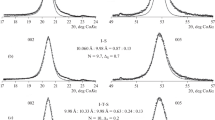Summary
With reference to the previously published papers byReynolds andHower (1970) andPerry andHower (1970) pelitic sediments from bore hole samples from the Tertiary sequence of the Vienna Basin have been studied to investigate the layer silicate assemblages and to carry out a quantitative estimation of the mixed-layering in the illitesmectite mixtures. Beside these problems one of the primary purposes of this paper is to indicate how interfering reflections from detrital layer silicates can be handled and resolved from diffraction patterns. The samples correspond to clayey silts. Within the less than 0.2 micron fractions they essentially contain mica, kaolinite and illite-smectite as expandable phase. Dependent on depth the composition of these mixtures is intermediate between an interstratified mixed layer phase consisting of about 75 percent smectite layers and 25 percent illite and an ordered mixture which contains about 20 percent smectite and 80 percent illite layers.
Since the mineral components maintain essentially constant portions throughout the samples, mica and kaolinite do not enter the illitization reaction. The necessary potassium and aluminum ions were derived from the nonclay constituents.
Zusammenfassung
In Anlehnung an die vonReynolds undHower (1970) sowie vonPerry undHower (1970) aufgezeigten Untersuchungsmethoden wurden an Beispielen von bohrproben tertiärer Feinkornsedimente aus dem Wiener Becken Untersuchungen zur Identifizierung und quantitativen Erfassung von Illit-Smektit Mixed-Layer-Phasen durchgeführt, wobei die Behandlung bzw. Ausschaltung von Störeffekten durch detritäre Mineralanteile im Rahmen dieser Methoden in den Vordergrund der Arbeit gestellt wird. Die durchwegs tonigen Silten entsprechenden Proben enthalten in der Fraktion kleiner 0,2 Mikron im wesentlichen Glimmer, Kaolinit und als quellfähige Phase Illit-Smektit, die mit zunehmender Teufevon einer Mischphase mit zufälliger Ordnung und 75% Smektit-bzw. 25% Illitanteilen zu einer geordneten Mixed-Layer-Bildung von 20% Smektit und 80% Illit überleitet.
Da die Zusammensetzung der Proben hinsichtlich der Verbreitung von Illit-Smektit, Glimmer und Kaolinit keine Veränderungen aufweist, können Beeinflussungen der beiden zuletzt genannten Phasen im Zuge des Illitisierungsprozesses ausgeschlossen werden. Die zur Illitbildung erforderliche Zufuhr von Kalium und Aluminium erfolgte demnach auf Kosten der Nicht-Ton-Minerale.
Similar content being viewed by others
References
Dunoyer de Segonzac, G., 1965: Les Argiles du Crétacé supérieur dans le bassin de Douala (Cameroun): Problèmes de diagenèse. Bull. Serv. Carte géol. Als. Lorr.17, fasc. 4, 287–310.
Heling, D., 1974: Diagenetic alteration of smectite in argillaceous sediments of the Rhinegraben (SW Germany). Sedimentology21, 463–472.
Hendricks, S. B., Teller, E., 1942: X-ray interference in partially ordered lattices. J. Chem. Phys.10, 147–167.
Hower, J., Eslinger, E. V., Hower, M. E., Perry, E. A., 1976: Mechanism of burial metamorphism of argillaceous sediment. 1. Mineralogical and chemical evidence. Bull. Geol. Soc. Amer.87, 725–737.
Johns, W. D., Grim, R. E., Bradley, W. F., 1954: Quantitative estimations of clay minerals by diffraction methods. J. Sed. Petrol.24, 242–251.
MacEwan, D. M. C., 1958: Fourier transform methods for studying scattering from lamellar systems. II. The calculation of X-ray diffraction effects for various types of interstratification. Kolloid Zeit.156, 61–67.
Mering, J., 1949: L'interférence des rayon-X dans les systèmes à stratification desordonnée. Acta Cryst.3, 371–377.
Perry, E., Hower, J., 1970: Burial diagenesis in Gulf Coast pelitic sediments. Clays and Clay Minerals18, 165–177.
Reynolds, R. C., 1976: The Lorenz factor for basal reflections from minerals in oriented powder aggregates. Amer. Mineral.61, 484–491.
Reynolds, R. C., Hower, J., 1970: The nature of interlayering in mixed-layer illitemontmorillonites. Clays and Clay Minerals18, 25–36.
Ruiz Amil, A., Ramirez Garcia, MacEwan D. M. C. 1967 X-ray diffraction curves for the analysis of interstratified structures. Inst. de Quimica Inorg., Cons. Sup. Inves. Cientificas. Madrid: Volturna Press.
Schultz, L. G., 1964: Quantitative interpretation of mineralogical composition from X-ray and chemical data for Pierre shale, U.S. Geol. Survey Prof. Paper 391-C, p. C1–C31.
Author information
Authors and Affiliations
Additional information
With 4 Figures
Rights and permissions
About this article
Cite this article
Johns, W.D., Kurzweil, H. Quantitative estimation of illite-smectite mixed phases formed during burial diagenesis. TMPM Tschermaks Petr. Mitt. 26, 203–215 (1979). https://doi.org/10.1007/BF01081846
Received:
Accepted:
Issue Date:
DOI: https://doi.org/10.1007/BF01081846




